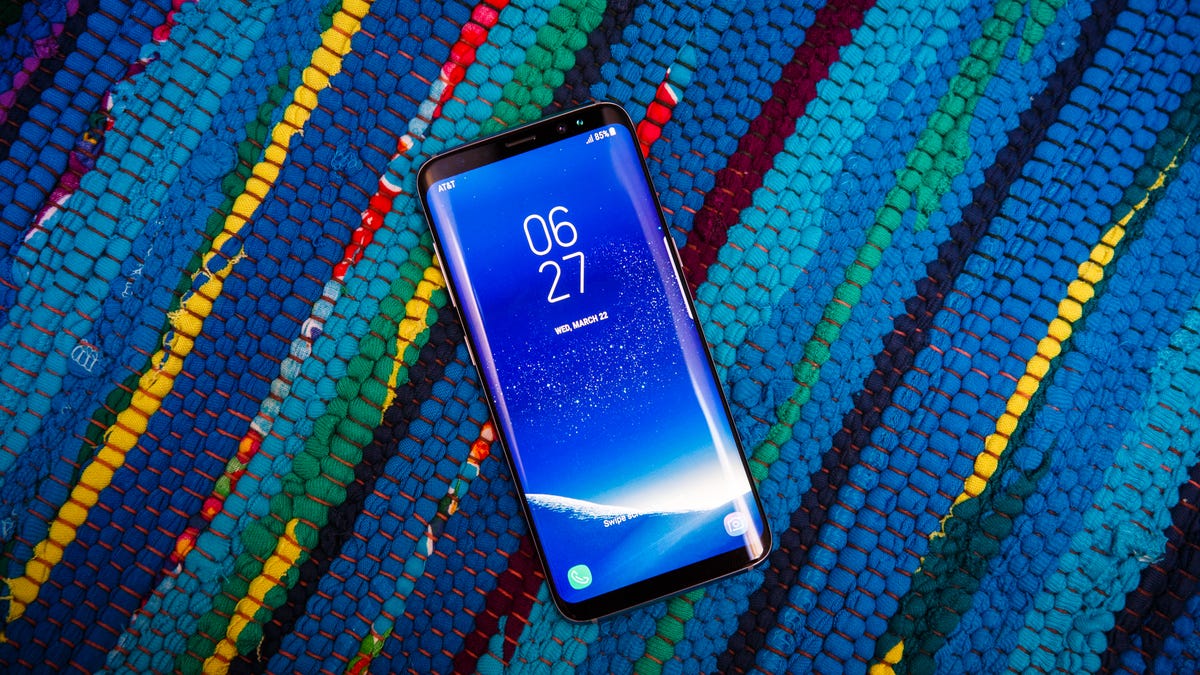Samsung Galaxy S8 first to get rip-roaring wireless speeds
The phone will be able to tap into the more-advanced cellular networks that carriers are just starting to kick into gear.

If you think the Galaxy S8 is fast now, give it a few months.
The headline change in Samsung's flagship phone, introduced this week in New York, is the massive display the company was able to cram into the device, thanks in part to the removal of the home button and much of the edges around the screen.
But hidden inside is another feature -- one that won't get to fully shine for another few months. The phone is the first to use the Snapdragon 835, the newest and fastest processor from Qualcomm. The Snapdragon 835 includes the ability to connect to so-called Gigabit LTE-class speeds, a benchmark that every US carrier is moving toward this year.
What's Gigabit LTE? Simply put, it's your 4G LTE connection with full afterburners on. The Galaxy S will be the first phone to tap into network speed as high as 300 megabits per second, or nearly 18 times better than the average speeds posted by Verizon and T-Mobile's recent performance in an OpenSignal test. To put that in perspective, it would take you 15 seconds to download a two-hour movie.
Yeah, fast.
Gigabit LTE won't just mean faster browsing -- it'll also enable new services like live 360-degree video streaming for virtual reality, and help power Google's vision of "instant apps," which are programs that load immediately like a website, according to Patrick Moorhead, an analyst at Moor Insights & Strategy.
It will also mean you'll be able to pull videos and photos from the cloud and they'll open instantly, as if they were already on your phone. The connection speed is actually faster than your phone reading a flash memory card.
"The cloud is an instant extension of your phone," said Sherif Hanna, who runs 5G and Gigabit LTE marketing for Qualcomm.
Not so fast
Gigabit LTE gets its name because you can supposedly get a wireless connection of 1 gigabit per second. What's confusing is that's the theoretical peak speed -- and no one will actually get anything that fast in the real world.
Don't expect to get those speeds immediately. The carriers can only get to this point after making several technical tweaks to their networks (that's where you'll hear terms like carrier aggregation and 4x4 MIMO -- but you don't have to worry about them). They're still working on the upgrades, meaning you're likely to see bigger speed boosts later this year.
Everyone's focusing on the Galaxy S8 display, but its Gigabit LTE capability may be more important down the line.
T-Mobile appears to be the closest. Shortly after Samsung unveiled the Galaxy S8, the company boasted that the phone will be able to get double the normal T-Mobile speeds in nearly 300 cities.
"You know what happens when you combine the most advanced LTE network in the country with Samsung's most powerful phone ever?" T-Mobile CEO John Legere asked in a statement. "An entire industry has to redefine the word 'fast.'"
Legere promised, during a press conference at CES 2017 in January, that T-Mobile would be the first to officially go to Gigabit LTE.
Sprint is working to get Gigabit LTE in several major markets starting in New Orleans. In addition to Gigabit LTE, the Galaxy S8 supports a technology called High Performance User Equipment, which is also supposed to provide a speed boost.
AT&T said it plans to deploy its first "5G Evolution" markets (its name for Gigabit LTE) in Indianapolis and Austin in the coming months.
Verizon confirmed it would also go to Gigabit LTE, but declined to offer more specifics.
Just the first
While the Galaxy S8 is the first to take advantage of these features, it won't be the last. Hanna said he sees 8 to ten different devices with Gigabit LTE capabilities hitting the market this year. Those phones will all use the Snapdragon 835 processor.
The Galaxy S8 is just the first in a line of Gigabit LTE-compatible phones.
The chip isn't a requirement to get Gigabit LTE access. Qualcomm offers a standalone X16 modem that accomplishes the same task, and are designed for companies that use a different processor. Apple, for instance, uses its own A10 chip to power its iPhone 7 and iPhone 7 Plus.
In Australia, where local carrier Telstra already has a Gigabit LTE network running, users need a mobile hotspot with an X16 modem to take full advantage of the higher speeds, Hanna said.
Beyond speed, getting more people on a Gigabit LTE network will free up the capacity of the network, meaning everyone will experience higher speeds, Hanna said.
It's no coincidence that the US carriers are all starting to offer unlimited data plans again. You can thank Gigabit LTE.
Virtual reality 101: CNET tells you everything you need to know about VR.
Tech Enabled: CNET chronicles tech's role in providing new kinds of accessibility.

